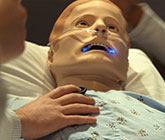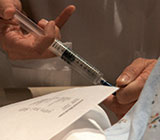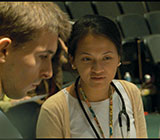Crisis Management
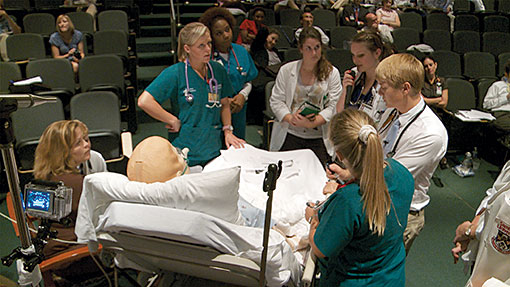
The patient was plastic—and his wife was actually a playacting nurse—but that didn’t make the situation any less tense. Last fall, two teams of future doctors, nurses, and other aspiring health professionals from UAB and Samford University did battle at UAB’s Spain Auditorium in the inaugural SimWars contest (see video here). The event, part of a weeklong workshop dedicated to innovation in medical education, showed off UAB’s high-tech mannequins, which train students in the schools of Medicine, Nursing, and Health Professions.
|
SimWars challenged |
The scenario involved |
The case, which involved |
Solving the medical mystery required the teams to administer a medication called methylene blue—an answer both groups figured out at about the same time. “This is how it’s going to be in real life,” says Nancy Tofil, M.D., UAB associate professor of pediatrics and co-medical director of the Children’s of Alabama pediatric simulation center. “The key to most patient care is teamwork, and as that care gets more complex, teamwork becomes more and more important.” |
||
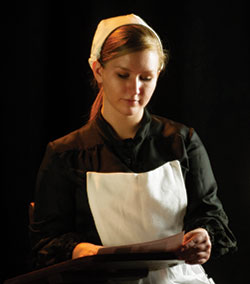
Pen Pal
Florence Nightingale didn’t really make a personal appearance, but UAB nursing student Laura Sullivan (above) played the part in a vintage costume last fall at the grand opening of a permanent exhibit at the UAB School of Nursing showcasing 50 original letters from the famous nurse. The letters were collected by Birmingham physician Lawrence Reynolds, M.D., and donated to UAB in 1958.
Pass the Menu
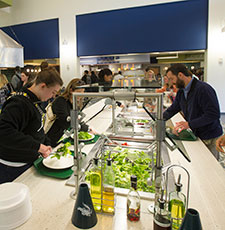 Climbing enrollment numbers at UAB mean lots of hungry mouths to feed on Southside. UAB Dining now operates 11 campus locations, anchored by the Commons on the Green. In 2010, Sterne Library reopened after a major makeover that added a ground-floor Starbucks. In 2011, Einstein Bros. Bagels opened in the Learning Resource Center. And 2012 saw the arrival of ZeBi (Zest Bistro) in the lobby of the Business-Engineering Complex, Cafe ASC at the Alys Stephens Center, and Simply to Go at Volker Hall.
Climbing enrollment numbers at UAB mean lots of hungry mouths to feed on Southside. UAB Dining now operates 11 campus locations, anchored by the Commons on the Green. In 2010, Sterne Library reopened after a major makeover that added a ground-floor Starbucks. In 2011, Einstein Bros. Bagels opened in the Learning Resource Center. And 2012 saw the arrival of ZeBi (Zest Bistro) in the lobby of the Business-Engineering Complex, Cafe ASC at the Alys Stephens Center, and Simply to Go at Volker Hall.
UAB Dining by the Numbers
- 63,000 – average number of diners per week, including 14,000 at the Blazer Café, 10,000 at Commons on the Green, 9,000 at the Diner, 2,700 at Einstein’s, and 2,600 at ZeBi.
- 105 – gallons of coffee sold per week at Starbucks at Sterne Library; Einstein’s sells 20 gallons, HUC Café and Commons on the Green sell 15, and Blazer Café sells 5 gallons.
- 250 – packs of sushi prepared daily at the Commons
- 18 – cooks working at Blazer Café. There are 17 at the Commons, 8 at the Diner, 2 at Einstein’s, and 2 at ZeBi
In the Lab
High-Tech Shelter from the Storm
Stronger than steel and up to 80 percent lighter, new high-tech panels created by researchers in the UAB Department of Materials Science and Engineering could represent the future of storm shelters. The panels, made from recycled liners once used to wrap piping on offshore oil rigs, are designed to be installed on the walls of an interior room in a typical home. Following successful testing from the National Storm Shelter Association, in which the panels survived repeated assaults by 15-pound two-by-fours fired at 100 miles per hour (see video here), the UAB group is now working toward commercial availability as soon as possible.
Healthy Adventure
For African-American teenagers living in the rural Deep South, HIV is a growing health threat. UAB researchers led by School of Nursing assistant professor Comfort Enah, Ph.D., are looking to video games as an escape route. Using a three-year, $271,000 grant from the National Institute of Nursing Research, the researchers are developing an individually tailored electronic adventure game targeted at youths aged 12 to 14. The game’s goals are to improve decision-making in this population and teach behavioral strategies to avoid sexual-risk behaviors.
Safe and Sound
Wallets are so old-school. The future of banking is NFC, or near-field communication, a technology that allows cellphones linked to a consumer’s bank account to talk to payment terminals at stores and other retail locations, skipping the need for plastic cards. Experts estimate that NFC payments totaled $240 billion in 2012 and could reach more than $670 billion by 2015. But there is a catch: Known security flaws could let criminals eavesdrop on NFC transactions and then start running up the charges on a customer’s account with their own purchases. UAB computer security researcher Nitesh Saxena, Ph.D., has developed a solution, however. Using the built-in audio capacities of cellphones, his system captures a brief snippet of audio from both the phone and the retailer’s reader. If the two don’t match (indicating that a criminal is trying to make a purchase from a remote location), the transaction is denied.
Drop that Doughnut
Animal studies suggest that pastries and other high-carb breakfasts may cause more trouble than a simple sugar rush: They appear to shut down the body’s ability to burn fat throughout the day. With a $160,000 grant from the Egg Nutrition Center, Barbara Gower, Ph.D., professor in the Department of Nutrition Sciences, aims to find out if this effect carries over to humans. She has recruited 30 adults between the ages of 55 and 75 for the study, which will test high-carb breakfasts versus those higher in fat and protein. “Your first meal of the day appears to program your metabolism for the rest of the day,” Gower says. “The concept we’re examining is that you burn more fuel and burn it more efficiently if you eat the right fuel at the right time of day.”
